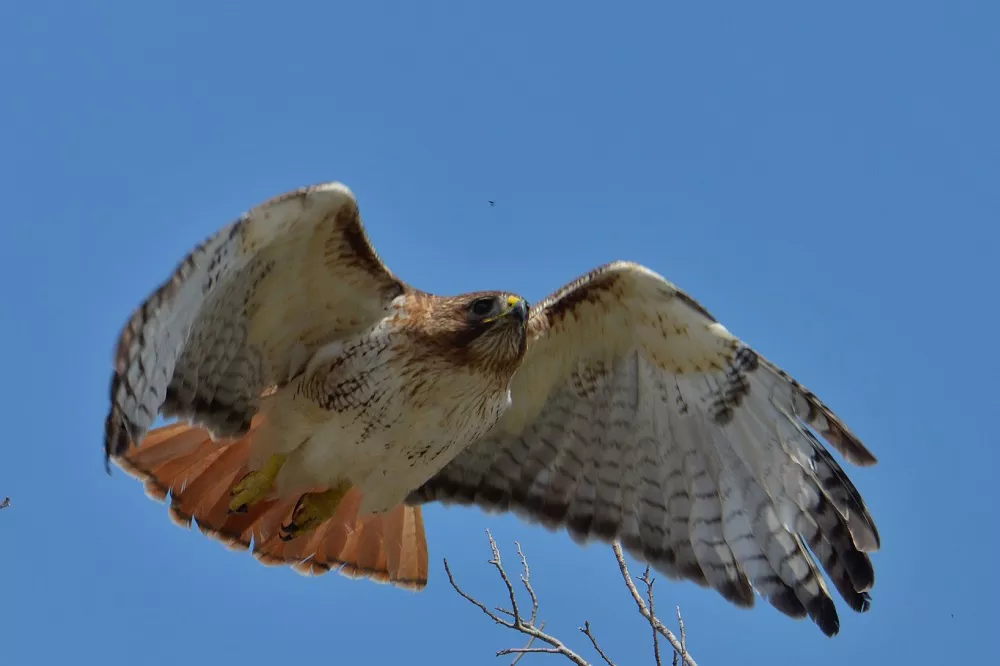The Red-tailed Hawk (Buteo jamaicensis) is a magnificent bird of prey that captures the imagination with its powerful flight and commanding presence. Renowned for its broad wingspan and robust build, the Red-tailed Hawk stands as one of North America’s largest and most iconic raptors. In this article, we delve into the dimensions and physical characteristics that make the Red-tailed Hawk a truly majestic and awe-inspiring species.
Size and Measurements:
Red-tailed Hawks are considered large raptors, exhibiting significant variation in size across their range. On average, adults measure between 18 to 26 inches (46 to 66 centimeters) in length from beak to tail. This measurement includes their distinctive long tail feathers, which play a role in their species name. The wingspan of an adult Red-tailed Hawk typically ranges from 43 to 56 inches (109 to 142 centimeters), showcasing their impressive aerial prowess. These dimensions highlight the Red-tailed Hawk’s stature as one of the largest raptors in its habitat.
Weight and Body Structure:
The Red-tailed Hawk is characterized by a robust and muscular build, enabling it to tackle a variety of prey and endure long flights. Adult Red-tailed Hawks typically weigh between 1.5 to 3.5 pounds (0.7 to 1.6 kilograms), with females being slightly larger and heavier than males. This weight allows them to exhibit the strength required to capture and carry their prey.
Physical Features:
The Red-tailed Hawk boasts distinctive physical features that contribute to its regal appearance. Its broad wings are an adaptation for soaring and gliding, allowing the bird to effortlessly navigate through its habitat. The wings are typically broad and rounded, equipped with primary and secondary feathers that provide exceptional lift and maneuverability during flight.
As its name suggests, the Red-tailed Hawk showcases a prominent reddish-brown tail. The upper side of the tail feathers displays this reddish hue, which becomes particularly pronounced when the bird is in flight. However, it is worth noting that juvenile Red-tailed Hawks do not acquire their red tails until they reach maturity, initially sporting a more mottled and streaked appearance.
Coloration and Morphs:
Red-tailed Hawks exhibit considerable variation in coloration, depending on their age, geographic region, and morphs. Adults typically display a combination of dark brown to black feathers on their back and wings, contrasted with lighter underparts. The breast and belly feathers may vary from pale cream to rich cinnamon. The head of the Red-tailed Hawk is typically light in color, featuring shades of tan, brown, or gray, often adorned with a distinctive dark mark or “belly band” across the lower portion of the belly.
Red-tailed Hawks also exhibit various morphs, including light, dark, and intermediate forms. The light morph showcases a predominantly pale underbody and head, while the dark morph exhibits a darker overall plumage. The intermediate morph displays a combination of light and dark markings. These morphs highlight the adaptability and diverse genetic variations within the Red-tailed Hawk population.
Size Comparison to Other Birds of Prey
While Red-tailed Hawks are considered large birds of prey, they are not the largest. The Golden Eagle (Aquila chrysaetos), for example, has a wingspan of up to 7 feet and can weigh up to 14 pounds. The Bald Eagle (Haliaeetus leucocephalus) is another large bird of prey, with a wingspan of up to 8 feet and a weight of up to 14 pounds.
Comparatively, the Red-tailed Hawk is smaller than these eagles but larger than other birds of prey such as the American Kestrel (Falco sparverius), which has a wingspan of around 2 feet and weighs only a few ounces.
Conclusion:
The Red-tailed Hawk’s impressive size, broad wingspan, and distinctive coloration command attention and admiration. Its robust build and majestic presence make it a true symbol of North American raptors. By understanding the dimensions and physical characteristics of the Red-tailed Hawk, we gain a deeper appreciation for the magnificence of these birds and the vital role they play in maintaining the delicate balance of ecosystems they inhabit.


 Facebook
Facebook  Instagram
Instagram  Youtube
Youtube 